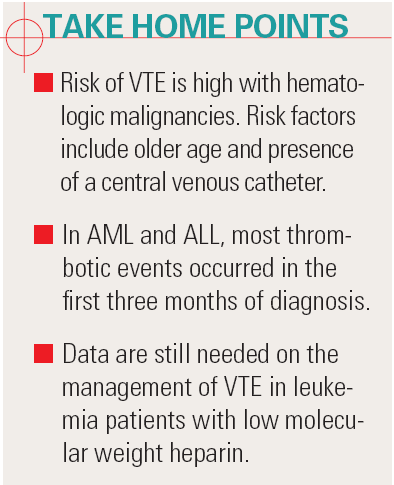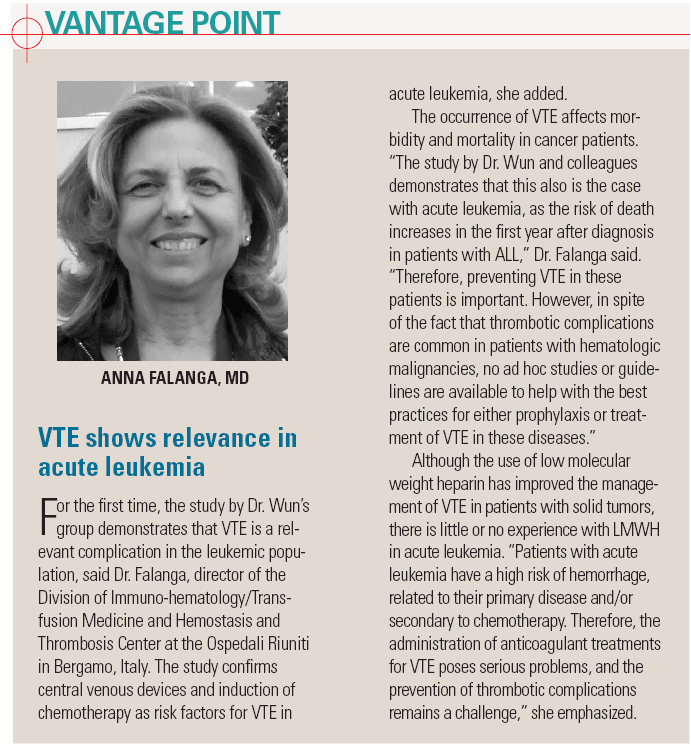Venous thrombotic events elevate chance of death in ALL, but no risk seen with AML
A large, population-based study of the association between venous thromboembolism and mortality in hematologic malignancies found an increased risk of death in patients with acute lymphoblastic leukemia, but not in those with acute myelogenous leukemia. The authors had no explanation for the differential association between the two types of acute leukemia.
ABSTRACT: VTE increased the risk of death by 40% in the first year after diagnosis in acute lymphoblastic leukemia, leading investigators to conclude that the complication is relatively common.
A large, population-based study of the association between venous thromboembolism and mortality in hematologic malignancies found an increased risk of death in patients with acute lymphoblastic leukemia, but not in those with acute myelogenous leukemia. The authors had no explanation for the differential association between the two types of acute leukemia.

“Although the association between cancer and thrombosis is well recognized, there has been a paucity of information on the risk of thrombosis and the impact of VTE on survival among patients with acute leukemia,” said Ted Wun, MD. “We concluded that VTE was a relatively common complication of acute leukemia, and the incidence in some patients may warrant testing the hypothesis that some subgroups may benefit from thromboprophylaxis.” Dr. Wun is a professor of hematology and oncology at the University of California, Davis, in Sacramento.
The study by Dr. Wun and colleagues set out to define the incidence and risk factors associated with VTE in acute leukemia. The study population included patients with acute leukemia diagnosed between 1993 and 1999 who were entered in the California Cancer Registry and the state’s Patient Discharge Database. During this time period, outpatient treatment of VTE was not standard practice (Blood 113: 3911-3917, 2009).
AML patients were predominately male with a mean age of 60.4 years. In the 5,934 cases of AML, the two-year cumulative incidence of VTE was 281 (5.2%). The average age of ALL patients was 25.3 years. More men than women had ALL (57.5% men vs 42.8% women). The preponderance of men was most striking among Hispanics with ALL, with 60.4% men and 39.6% women. In the 2,482 cases of ALL, the two-year incidence of VTE was 4.5%.

In both AML and ALL, most of the thrombotic events occurred in the first three months of diagnosis, with the incidence decreasing quickly over time. “The high rate of VTE in the first three months likely reflects a contribution of therapy to VTE pathogenesis,” Dr. Wun said.
Although many oncologists/hematologists have assumed that the risk of VTE is higher with solid tumors than with hematologic malignancies, this study and others suggest that this is not the case. “Many would assume that the incidence of VTE might be low in patients with acute leukemia, given thrombocytopenia and coagulation factor deficiencies often found in these patients. However, the overall two-year incidence of any thrombosis in acute leukemia-5.2% in AML and 4.5% in ALL-is appreciable and similar to the incidence of thrombosis observed in patients with solid tumors, including colon, esophageal, and renal cancer in some analyses,” Dr. Wun noted.
Risk factors for VTE among patients with AML and ALL were older age, number of chronic comorbidities, and presence of a central venous catheter. For AML, but not ALL, female gender was also a risk factor. In fact, a robust multivariate analysis of risk factors found that women with AML had a 40% greater risk of developing VTE than men. This gender-related finding has not been previously reported, noted the authors, and is currently unexplained.
The authors estimated that more than half of the total thrombotic events in both types of acute leukemia were likely to be catheter-related upper extremity thrombosis. “Thus, lower extremity deep vein thrombosis and pulmonary embolism was not unusual,” Dr. Wun said.
The authors cautioned that their results may not have general application to present-day practice because of changes since 1999 in routine VTE prophylaxis, rates of central venous catheter-associated thrombosis, and leukemia therapy. Also, overall rates of VTE in hospital patients have increased.
